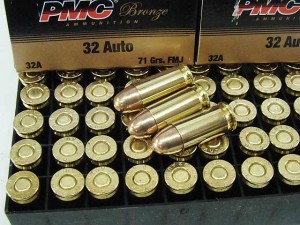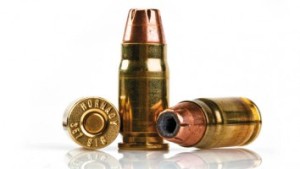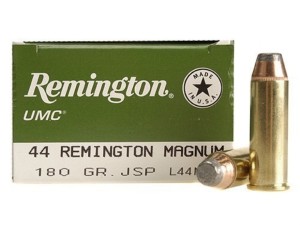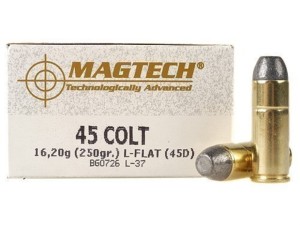For those of you new to shooting, I imagine the number of ammo calibers available is dizzying. On top of that amazing array we throw in both digital and imperial measurements for fun. Let’s do a quick review of what’s on the market for general, common, center-fire handguns. We’ll look at these eleven cartridges:
- .32 ACP
- .380 ACP
- .357 S&W Mag
- .357 SIG
- .38 S&W Special
- 9mm PARA
- 10mm Auto
- .40 S&W
- .44 Rem Mag
- .45 ACP
- .45 Long Colt
The .32 caliber is one of the smallest still generally available. It was designed by John Moses Browning (yep, the same guy that invented the famous Colt 1911) and introduced in 1899 by Fabrique Nationale. The bullet is .32 inches in width. The Walther PPK comes in .32 ACP (Automatic Colt Pistol).
Next up are FIVE cartridges that use the same size bullet. They are the .380 ACP, the .38 Special, the .357 S&W, .357 SIG and the 9mm PARA. They all sound different, how can they be the same?
Good question! The size of the .38 Special bullet is actually .357 inches, which is 9.07mm. The difference in these cartridges is their power and the firearms in which they fit.
The .380 ACP is a rimless, straight-walled pistol cartridge developed by John Moses Browning. Colt introduced the .380 ACP in 1908. It’s a short cartridge and is used in several smaller semi-automatic pocket pistols, including last year’s GLOCK 42.
The .38 Special has been around since 1898. It’s a center-fired rimmed cartridge used in revolvers. It is the most popular revolver cartridge in the world today. The .38 Special can be fired from .357 Magnum revolvers. The reverse is also true, but unsafe, as the magnum cartridge produces much higher pressures.  The .357 S&W Magnum was introduced in 1934 and is also a straight-walled, rimmed revolver cartridge. The .357 SIG was developed in 1994 by SIG Sauer. The new cartridge was named “357” to highlight its purpose: to duplicate the performance of 125-grain .357 Magnum loads fired from 4-inch barreled revolvers, in a cartridge designed to be used in a semi-automatic pistol with greater ammunition capacity than a revolver.
The .357 S&W Magnum was introduced in 1934 and is also a straight-walled, rimmed revolver cartridge. The .357 SIG was developed in 1994 by SIG Sauer. The new cartridge was named “357” to highlight its purpose: to duplicate the performance of 125-grain .357 Magnum loads fired from 4-inch barreled revolvers, in a cartridge designed to be used in a semi-automatic pistol with greater ammunition capacity than a revolver.  The .357 SIG is the first modern bottleneck handgun cartridge available since the 1960s.
The .357 SIG is the first modern bottleneck handgun cartridge available since the 1960s.
The 9mm Parabellum or Luger was designed by Georg Luger (for his Luger pistol) and introduced in 1902 by Deutsche Waffen- und Munitionsfabriken (DWM) for their Luger semi-automatic pistol. DWM’s company motto was, “If you seek peace, prepare for war,” which in Latin is, “Si vis pacem, para bellum.” Hence the 9mm PARA label, which is short for parabellum.  The 9mm is by far the world’s most popular handgun cartridge. It is also a rimless, straight-walled and center-fired.
The 9mm is by far the world’s most popular handgun cartridge. It is also a rimless, straight-walled and center-fired.
The 10mm Auto was developed by Jeff Cooper and introduced in 1983. His goal was to design a cartridge that had the stopping power of the .45 ACP but with the speed and trajectory of the 9mm PARA.  The 10mm is very powerful, with the flat trajectory and high energy of a magnum revolver in a rimless, center-fire cartridge.
The 10mm is very powerful, with the flat trajectory and high energy of a magnum revolver in a rimless, center-fire cartridge.
In 1986 there was a terrible shoot-out in Miami, Florida. The FBI lost two agents. This resulted in a quest for a replacement of the revolver with a semi-automatic handgun. This would provide the FBI with more rounds and faster reloads. They tested the 9mm PARA, .45 ACP and the relatively new 10mm Auto. The 10mm won the tests, but it had some hefty recoil and the guns had a fairly robust grip size. This began the quest for 10mm power in less felt recoil. Thus the .40 S&W was introduced by S&W in 1990, but GLOCK brought the first .40 S&W handguns to market before Smith & Wesson with the GLOCK models 22 and 23. 🙂
The .44 Remington Magnum is, as Clint Eastwood’s Dirty Harry put it,
“Uh uh. I know what you’re thinking. ‘Did he fire six shots or only five?’ Well to tell you the truth in all this excitement I kinda lost track myself. But being this is a .44 Magnum, the most powerful handgun in the world and would blow you head clean off, you’ve gotta ask yourself one question: ‘Do I feel lucky?’ Well, do ya, punk?”
 The .44 is a rimmed, straight-walled, center-fired revolver cartridge designed by tweaking the .44 Special cartridge by Elmer Keith and used first in the 1956 S&W Model 29 revolver and then the Ruger Blackhawk.
The .44 is a rimmed, straight-walled, center-fired revolver cartridge designed by tweaking the .44 Special cartridge by Elmer Keith and used first in the 1956 S&W Model 29 revolver and then the Ruger Blackhawk.
 The .45 ACP was designed by John Moses Browning in 1904 for his new Colt semi-automatic .45 pistol, which was adopted as the issued US military sidearm in 1911, thus birthing the venerable Colt M1911 pistol. It basically replaced single-action revolvers such as the Colt Single Action Army (SAA) revolver, which was loaded with the .45 Long Colt cartridge, which dates back to 1872, and adopted by the US Army in 1873.
The .45 ACP was designed by John Moses Browning in 1904 for his new Colt semi-automatic .45 pistol, which was adopted as the issued US military sidearm in 1911, thus birthing the venerable Colt M1911 pistol. It basically replaced single-action revolvers such as the Colt Single Action Army (SAA) revolver, which was loaded with the .45 Long Colt cartridge, which dates back to 1872, and adopted by the US Army in 1873.  (I have a replica 1873 Colt SAA made by Uberti that is a delight to hold and a joy to shoot.) The .45 Long Colt is a rimmed, center-fired cartridge that’s nearly as big as your thumb.
(I have a replica 1873 Colt SAA made by Uberti that is a delight to hold and a joy to shoot.) The .45 Long Colt is a rimmed, center-fired cartridge that’s nearly as big as your thumb.
And that’s our recap. In summary, here are those eleven cartridges again with their date of introduction – and a conversion into millimeters to help you get a feel for the relative sizes.
- .32 ACP – 1899, 7.65mm
- .380 ACP – 1908, 9mm
- .357 S&W Mag – 1934, 9mm
- .357 SIG – 1994, 9mm
- .38 S&W Special – 1898, 9mm
- 9mm PARA – 1902, 9mm
- 10mm Auto – 1983, 10mm
- .40 S&W – 1990, 10mm
- .44 Rem Mag – 1956, 10.9mm
- .45 ACP – 1904, 11.43mm
- .45 Long Colt – 1872, 11.43mm
The two main rimfire cartridges on the market today are the .17 HMR (Hornady Magnum Rimfire) developed in 2002 and the .22 LR (Long Rifle), developed in 1887.
If you look at the sizes in millimeters you should begin to notice some familiar sizes. The smallest cartridge in our list, the .32 ACP is 7.65mm. This is the same size round fired from the AK-47. The M16 and AR-15 fire the 5.56mm NATO round, which is actually smaller than a .22 LR, which is 5.6mm. The rifle bullets simply go much faster than the handgun rounds!
Take a look at the ages of these cartridges! Over half of them have been around well over 100 years. That’s why I take notice of changes in the world of firearms. They are few and far between. 🙂
You read above about the FBI reacting to the terrible ’86 shootout in Miami and their quest for a better round. They chose the .40 S&W. Last year, they decided that the 9mm cartridge, with 30 years of ballistic upgrades, is perfect for them now (along with most of the police forces in the country, as well) and they have authorized their agents to carry 9mm handguns. So bye-bye to the .40 S&W.
Now the US Army is another story, sadly. After establishing the venerable .45 ACP for combat use for 75 years, they switched to the 9mm round in 1985. The Beretta M9 has been on the hips of soldiers for 30 years. But now they’re looking for more stopping power. I believe the answer is to change to JHP rounds instead of the ball ammo we all use at the range, but there’s always the .45 ACP!
Good shooting!
JoeGLOCK
